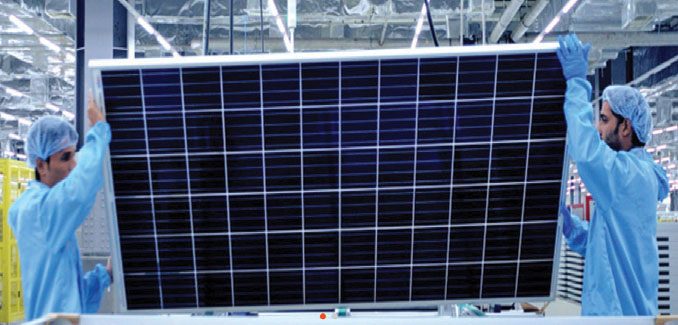
In the Indian solar power space, where the majority of modules are imported, there are some domestic manufacturers that are trying to match the scale and price offered by their Chinese counterparts. Adani Solar is one such player that has emerged as a leading domestic integrated solar photovoltaic (PV) manufacturer. The solar manufacturing arm of the Adani Group, the company has its manufacturing unit in the electronics manufacturing cluster of Muna in Gujarat, and hence is also known as Mundra Solar PV Limited.
Background
The Adani Group entered the solar power segment as early as in 2011, when Adani Power commissioned a 40 MW solar power project in the Kutch region of Gujarat. In 2015, the group was restructured, following which Adani Enterprises Limited (AEL) became responsible for executing the group’s solar and wind power projects through its unit, Adani Green Energy Limited. In February 2015, AEL signed an MoU with US-based SunEdison to jointly invest $4 billion in setting up an integrated solar PV manufacturing plant in Gujarat. AEL was in talks with Taiwan-based Foxconn for a possible joint venture. However, none of these deals ultimately panned out. Thus, AEL decided to go solo, and got an in-principle approval from the Gujarat government in April 2016 to begin work on a solar manufacturing unit in Mundra. The unit is strategically located in Mundra’s electronics manufacturing cluster, which enables it to leverage the existing power, logistics and shipping infrastructure, as well as the locational advantage of other nearby industries like backsheets and electronic components. Mundra Solar PV Limited was set up as a special purpose vehicle by AEL for its solar manufacturing business. The unit was planned to be set up in three phases. The first phase of 1.2 GW of solar cell and module manufacturing capacity was planned to be completed in a year, at an estimated cost of Rs 20 billion. In the second phase, the manufacturing unit was planned to be scaled up to 3 GW, and in the third phase, polysilicon production was to start with a total planned capacity of 10,000 tonnes. The completed facility would vertically integrate all aspects of solar panel production on site including polysilicon refining, and ingot, wafer, cell and module production. The unit finally began operations in May 2017.
Product portfolio and future plans
As of June 2019, Adani Solar has a manufacturing capacity of 1.5 GW premium cells and modules, of which 1.2 GW is for polycrystalline technology. Apart from conventional polycrystalline modules, the facility manufactures 200 MW of high efficiency mono-passivated emitter rear contact modules, which guarantee higher efficiencies than conventional modules. The integrated plant also manufactures about 100 MW of bifacial modules, which claim even higher efficiency gains. The facility can also manufacture customised size-specific modules. The company plans to invest in further advanced technologies like passivated emitter rear totally diffused, multi-busbar, tunnel oxide passivated contact, hetero-junction and interdigitated back contact solar cells in the future. With 1.5 GW of installed manufacturing capacity, the company claims a share of 10 per cent in the domestic module industry. In the near future, the company plans to scale up its capacity to 3 GW of modules and cells in the same facility, and increase its share to 50 per cent of the market. Apart from catering to the growing demand of the solar industry, both in India and abroad, this increase in manufacturing capacity will help meet the parent company’s larger solar power development goals. The company has already initiated extensive collaborations with various channel partners for retail distribution of its solar panels, to cater to a variety of grid-connected and off-grid applications. As of May 2019, it has established a retail network of solar panels in Rajasthan, Uttar Pradesh, Delhi, Gujarat, Punjab, Haryana and Kerala, and plans to extend this to other states as well.
Outlook
Safeguard duties, combined with competition from cheaper and more advanced foreign products, changing interest rates and tax structures, and rapid technological upgradations pose challenges for domestic manufacturers. Adani Solar too faces similar challenges. Its solar modules are not exempt from safeguard duties, despite being produced domestically, as it is located in a special economic zone. However, the company has aggressive expansion plans that come at a time when the government is planning massive manufacturing-linked auctions and other schemes. In addition, its parent company, the Adani Group, has businesses in all segments of the power industry – generation, transmission and distribution – and is planning extensive solar power capacity addition. The in-house demand for solar modules, combined with a huge production facility, will indeed give the company a larger market share in the future. The Adani Group’s deep pockets give Adani Solar a strong edge over its competitors, due to its ability to better absorb market risks and policy fluctuations. In sum, Adani Solar is strongly positioned to become a market leader in the solar manufacturing segment.
By Khushboo Goyal
